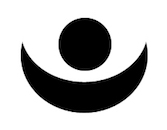In our fast-paced world, rest has become a crucial aspect of maintaining our mental and physical well-being. While sleep is the most well-known form of rest, there are other types that are equally essential for our overall health. Understanding and incorporating the seven types of rest into our daily lives can help us recharge and stay focused, leading to increased sense of achievement and well-being. In this article, we’ll explore these seven types of rest and provide tips for incorporating them into your routine.
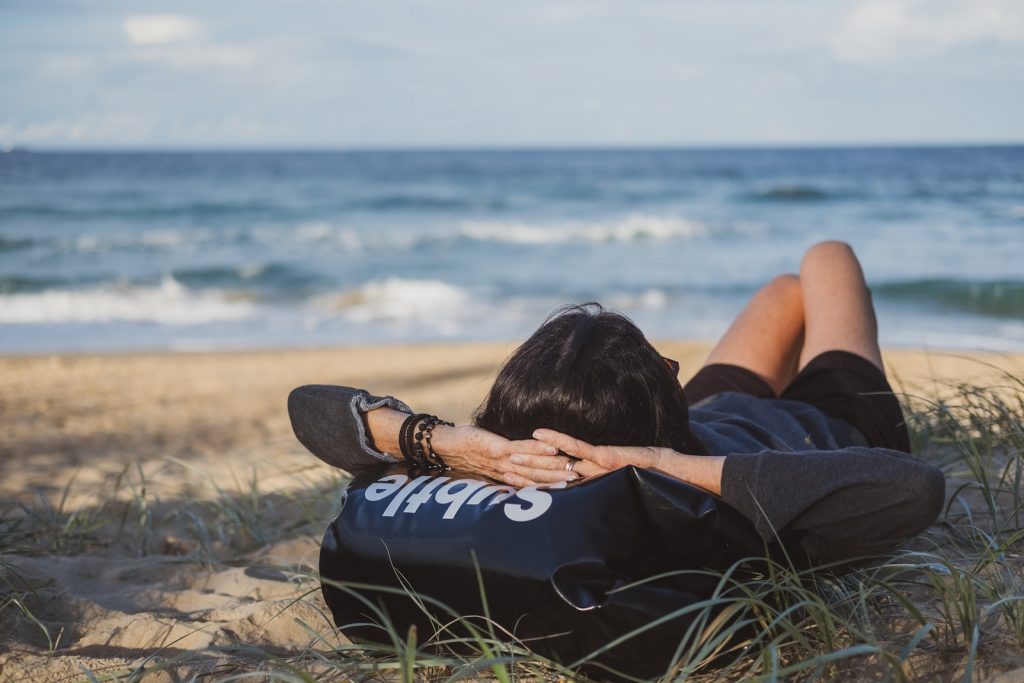
Physical Rest
Physical rest is the most familiar form of rest, and it’s often associated with sleep. However, it can also include other activities that allow our muscles and joints to recover from the strains and stresses of daily life. Examples include stretching, yoga, and massage. Incorporating physical rest into your day can reduce fatigue, improve muscle recovery, and lower the risk of injury.
Mental Rest
Mental rest is essential for reducing brain fog and maintaining focus throughout the day. This type of rest involves taking breaks from cognitive tasks, such as problem-solving, decision-making, and creative thinking. Meditation, mindfulness exercises, and stepping away from screens can all help in providing mental rest. Aim for periodic short breaks during the day and create a routine that allows your mind to recharge regularly. Taking a mindful tea break or a mindful moment outside can really make a difference.
Emotional Rest
Emotional rest focuses on processing and expressing our feelings to maintain emotional balance. This type of rest can be achieved through journaling, therapy, or simply having open conversations with a trusted friend or family member. By addressing our emotions and allowing ourselves to be vulnerable, we can experience relief and a sense of emotional well-being. It’s often said in mindfulness practice; what we feel, we heal.

Sensory Rest
Sensory rest is essential for counteracting the constant bombardment of stimuli from our environment, such as noise, light, and screen time. To practice sensory rest, create a calm and quiet space where you can retreat and unplug. Activities like reading a book, taking a walk in nature, or closing your eyes for a few minutes can all help to reduce sensory overload and provide restorative benefits. Earplugs can also be really valuable to increase sensory rest when you share space with others and it’s harder to find quiet.
Social Rest
Social rest is the act of finding balance between socialising and solitude. This type of rest can involve spending time with people who recharge your energy or seeking out moments of solitude to regroup and reflect. Identify which relationships in your life provide support and comfort, and make an effort to prioritise those connections.
Creative Rest
Creative rest is the process of rejuvenating our creative energies and nurturing our imagination. It involves stepping away from our usual creative outlets and engaging in activities that inspire and invigorate us. Visiting an art gallery, attending a concert, or exploring a new environment can all help to stimulate our creativity and provide the rest our minds need to stay innovative.
Spiritual Rest
Spiritual rest is the practice of connecting with a higher power, whether that is through religion, spirituality, or a sense of purpose in life. This type of rest can help us find meaning and foster a sense of inner peace. Spiritual rest can be achieved through prayer, meditation, or participating in religious or spiritual activities that resonate with your beliefs.
Incorporating the seven types of rest into our daily lives can help us maintain a balanced and healthy lifestyle. By understanding the different ways we can rest, we can address our individual needs and prioritise self-care. So, take a moment to assess which types of rest are missing from your life and begin to create a well-rounded rest routine that supports your overall well-being.
Rest doesn’t need to be another thing that’s added to your ‘to do’ list. Once you identify which types of rest you need more of, try adding micro-doses of rest into your day as often as possible. Leave yourself post-it note reminders, set alarms on your phone, add mini rest breaks to your calendar – whatever it takes to create the habit of healthy rest.
Join us at The Well Nest for regular workshops, classes and retreats to help you find rest and self-care.
Shamanism for Modern Life
Modern life is difficult – we all know this! Sometimes it’s hard to find exactly why it appears to be such a struggle – are we doing it wrong? Are other people finding it much more easy to navigate the challenges of modern life than we are?
The answer to both of these questions is largely no. Life is an art not a science – we aren’t doing it wrong and others aren’t having more success at it than we are (although social media and the art of ‘appearing happy’ would have us believe otherwise).
But…we do know that there are a lot of things we could do to help ourselves. Exercise, meditation, relaxation, therapy…all these things can help us sort through the difficulties of life and find more ease. Shamanism can help us find balance and ease with life too.
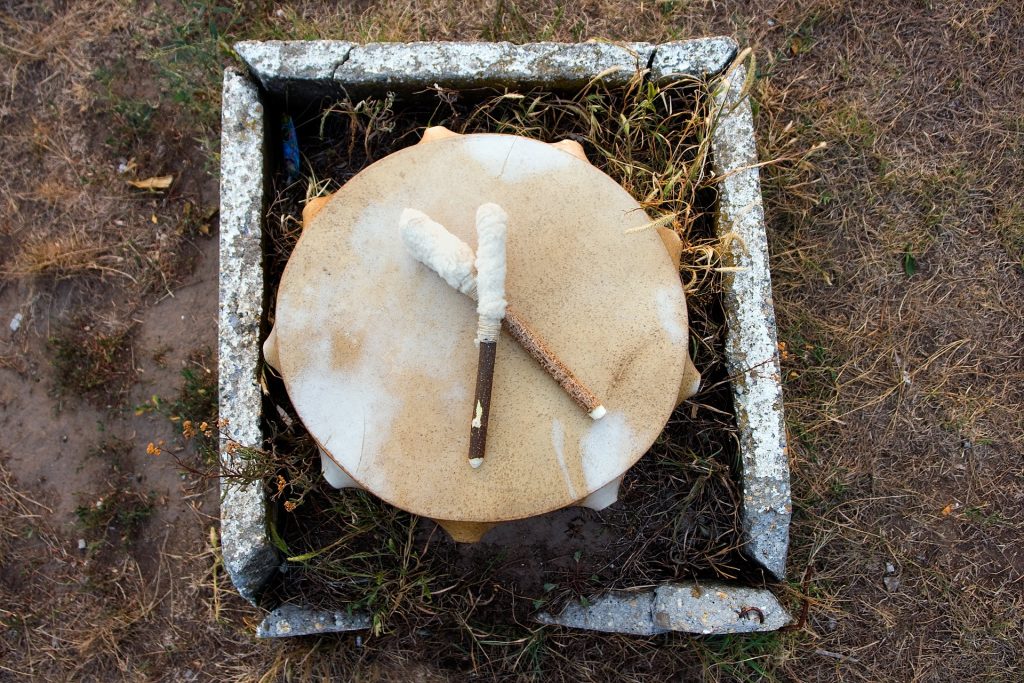
What is Shamanism?
Shamanism is one of the oldest systems of finding balance, harmony and wholeness that humans across the globe have relied upon for healing and wellbeing. Shamanism seeks connection to nature, to all of life, in order to find our balance and wellness.
Humans are animals, but with the development of modern society and cultural progression, we have lost touch with our foundations as creatures of the earth and have become largely separate. Living separate lives, looking after ourselves, losing the sense of community and balance with nature that is so fundamental to wellbeing.
There is a reason why so many wellbeing techniques rely on balance: re-aligning energy flows, using essential oils to correct imbalance, seeking inner stability of mind through finding balance between calmness and productivity. Modern life has thrown us out of balance. We live inside manufactured environments, surrounded by electronic devices, eating processed food and trying to protect our egos. This is not the natural life of an animal. It’s no wonder we desperately need help with our wellbeing.
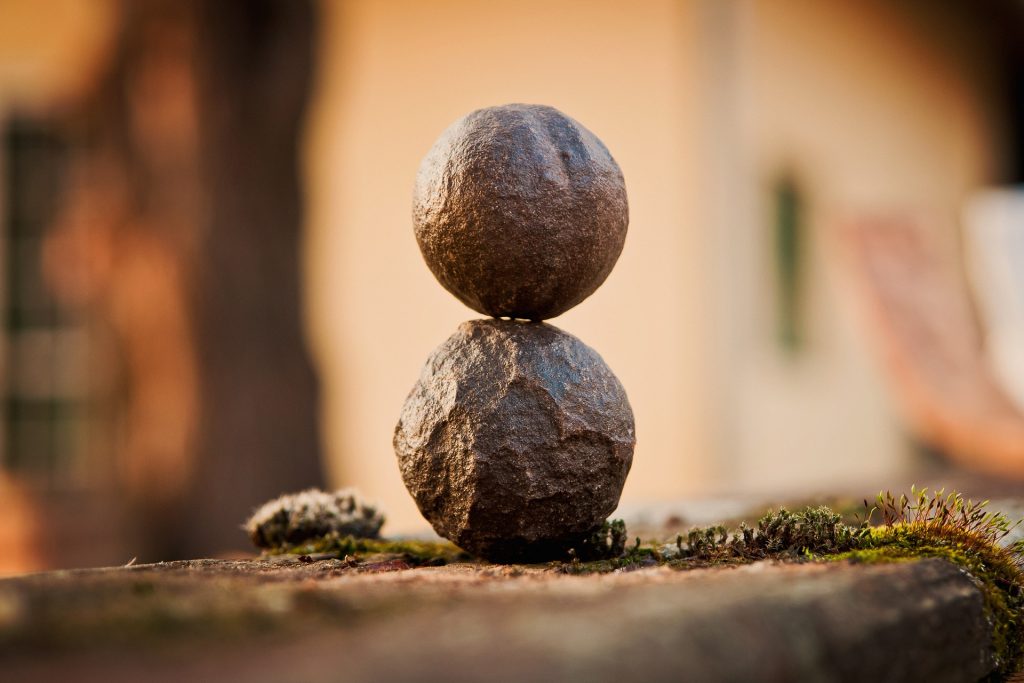
Why is Shamanism Relevant and Useful Now?
Shamanism is concerned with reigniting our nature connection. Re-discovering our place within the landscape of the earth and all of the life-forms within it. This is so relevant in today’s world where we desperately want to find that balance for ourselves, but with equal vigour, want to protect our precious environment so the earth can heal too.
Shamanism teaches us to live respectfully but to view ourselves as a part of something bigger. Part of the collective consciousness that all living beings can connect to. Shamanism is also a form of self-development. Practices give us a chance to live at peace, offering kindness and patience for the benefit of ourselves and others.
The Shamanic Journey and How it Can Help
The Shamanic Journey allows you to quiet the logical, thinking mind and access the subconscious; where our memories of living more harmoniously reside. The ego doesn’t run the show in the subconscious mind. We can access a place where we are able to work with intention and seek guidance on how to find the harmony and wholeness that is often missing from our modern life.
On a Journey, we can speak to other beings that appear to us and receive help on finding a new way to travel through life with more ease. Perhaps we are seeking answers to questions in life, perhaps we are looking for a new direction, or perhaps we are just curious. Nature is a great place to seek guidance; from the ancient wisdom of the earth that we have lost touch with as our society has developed into separateness.

Find out more and take a Journey…
Sometimes, it feels as though life doesn’t quite flow as smoothly as it could, or patterns of behaviour and experience often repeat themselves. The Shamanic Journey offers a way to gain insight into your path, your future plans and how to find balance.
The Journey is a meditation to the beat of the shamanic drum; the sound waves taking the mind to a place of relaxation and vision not usually accessible to the logical, conscious mind. Allow your logical, thinking mind to rest as your brainwaves adjust to the drumbeat and a new realm of the subconscious mind reveals itself to you.
Understand how to live with nature and all beings with more ease; flowing through life rather than resisting it. Appreciate the fullness of life and all that it has to offer when we understand our place in the universe.
Next Shamanic Journey Meditation Workshop is Friday 1st November 6 pm – 8 pm at TopLine Studio.
Essential Oils for Fighting Colds
As the nights get longer and colder and the days get damper, the inevitable cold and flu season approaches. Chances are we will all suffer from a seasonal cold; whether it’s a head cold that lasts a few days or something a little more persistent that knocks you back for a few weeks, it’s good to know how you can help yourself to recover.
Waging war on the common cold often seems like a lost cause with most of us resorting to over the counter remedies that allow us to ‘soldier on’ at home and at work. Keeping warm and drinking fluids is good advice, but what if there was something more you could do?
Essential oils have some powerful properties to fight the common cold and can be used as part of a self-care routine that in itself can help you feel much better. Although I wouldn’t recommend casting aside medical advice in favour of home remedies, there are things you could try to complement medical advice that could help you feel better physically and mentally and get you back on your feet sooner.
So what can you do? There are a number of essential oils that have been used for centuries (and proven in modern trials) to combat the symptoms of colds.
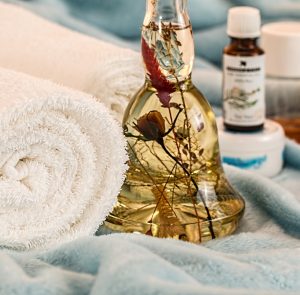
Oils you might like to have in your basic care kit:
Cinnamon, clove or rosemary – if mixed with warm water, can be effective as a surface cleanser or room mist to combat bacteria, viruses and fungus
Chamomile (Roman)– excellent at relieving cold and flu symptoms as it has antiseptic and antibacterial properties. It also has calming and sedative properties
Eucalyptus (Radiata) – Excellent in fighting respiratory tract infections
Lavender – Excellent calming effects and helps with sleep. Can also be used to treat headaches
Lemon – Has stimulating effects on the digestive system and is great at relieving headaches. Is generally good at uplifting mood and has antiseptic properties (making it great for room mist)
Peppermint – A wonder oil with analgesic, antiseptic, cooling and anti-inflammatory properties. Can relieve mucus and catarrh and relieve headaches
Tea Tree – An all-rounder for cold fighting; antiseptic, antibiotic, antiviral and antifungal. If you find the scent too antiseptic, it can be easily blended with lemon to disguise it.
Thyme (Linalol) – Great at fighting infections or contagious conditions and also at stimulating the immune system.

How to use the oils:
Steam – add up to 4 drops to a bowl of hot water and inhale the steam (placing a towel over the head). This is particularly useful for mucus, catarrh and headache relief. Alternatively, to get the benefits of steam and topical application, add a blend to the bath and soak yourself until you feel relief.
Topical application – a foot or hand massage is a great way to get the benefit of the oils and the relaxation of a massage. Add an oil blend to a carrier oil (such as coconut or grapeseed) and massage into hands and feet before bed. Blend the oils in the following quantity: 5 ml carrier oil, 1 drop of essential oil. 10 ml of carrier oil, 5 drops of essential oil.
Room mist or surface cleanser – Adding drops of a blend (up to 6 drops to 500 ml water, test on surfaces before full use) to warm water and shaking well (in a misting spray bottle) can make for an effective surface cleanser or room mist to clear away infectious microbes or bacteria.
Oil burner – get the benefits of the oils while relaxing in front of the TV or a good book. Add drops of essential oil (up to 5 drops) to 10ml of water and heat in an oil burner (over a candle). The room will be cleansed as well as your airways.
Experiment with blends that appeal to you as fragrances as well as for their cold and flu fighting properties and you will find something that works well for your mind as well as your body. Instead of fighting through and carrying on as normal, take some time to care for yourself through bathing with essential oils, giving yourself a massage or relaxing in a candle-lit room with an oil burner. Colds need not be the struggle that they usually are.
Om Yoga Show Manchester 2018 – Review
I’m a big fan of the Om Yoga Show; this must be the eighth or ninth time I’ve been to the show over the years and the third time visiting the ‘Northern version’ up in Manchester. I enjoyed the show last year and generally find it a much more enjoyable experience than the London version of the show.
Travelling to Manchester is pretty easy from the Midlands by train or car and helpfully, the organisers had kept the venue the same as last year; Event City, right next door to the Trafford Centre (and with free parking woohoo!). I went up on the first day of the show (Friday) and arrived at about 11.30 am and was surprised to see a giant queue to get in, stretching all the way into the car park. I got chatting to a fellow yogi in the queue and she agreed that it hadn’t seemed this busy last year. luckily the queue moved quickly and we got inside to find the hold-up had been due to staff trying to fill and hand out goody bags right in the doorway. Just as we got to the front of the queue we were told the goody bag area was causing a hold-up (no kidding) and so we would have to come back later to collect ours. No problem, as I didn’t fancy carrying the massive paper bag round the show with me.
As it turned out, I could have done with the massive bag to carry all my purchases – I still forget that nobody gives you a carrier bag anymore! The freebies inside this year included samples from BIO-Extracts of face cream, anti-oxidant boost and anti-wrinkle boost and some NOUGHTY leave in conditioner. I gently turned down the free sample of cider vinegar (even though I heard a lively discussion about how it can be effective if applied to acne – not sure which is worse; spots or smelling like vinegar??)
What was on
There was a good variety of stands on offer again this year – about 100 to choose from. This included food and drink, equipment, books, music, clothing, retreats and teacher training, meditation aids, and my personal favourites singing bowls and gongs. I played lots if different singing bowls and had a good chat to the owner of the Moon Karma stand (who was also an ashtangi running yoga retreats in Nepal…that went straight on the to do list). There were also three open classes and two workshop areas and a meditation area. The ticket price of £7.50 for one day entry was a bargain as usual as this allowed access to the show and free entry to all the classes in the open and meditation areas. It also included free entry to Vegan Life Live and the Mind Body Soul Experience.

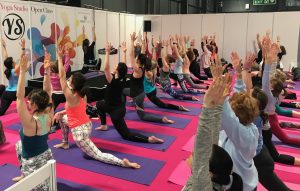
What to do
I started with my usual quick circuit of the stands to find out what was where and who/what I’d like to revisit. Despite the big queues to get in, the show was not overcrowded and it was always easy to see and speak to any of the exhibitors. It was great to see the open classes so well attended. It’s never necessary to queue for more than 5 minutes at the Manchester show to take part in a free class, whereas I have been known to spend 30 minutes waiting at the London show only to be told the class is full.
The open classes this year included traditional Hatha yoga, inversions, singing bowl meditation, chair yoga, crystals, alignment, how to flow, yoga for MS, Kundalini, Kriya yoga, and vinyasa flow to name but a few. There was also a children’s yoga open area. I didn’t have chance to try and open class this year as I had two workshop bookings, but I did stop to watch a few. The Kundalini open class run by KYTA was fascinating; they played some fantastic music which really did help to connect mind and body (and I was only observing!). That one is going on my list for next year. The classes were full, but I didn’t see anyone get turned away so even if you don’t have a workshop booking, it’s worth coming to the show to try a new style of yoga for free. The DRU Yoga area had loads of free taster sessions going on all day as well – I’ve participated in these before and they are well worth the experience. I always think DRU would be the perfect yoga class to get you going in the morning.
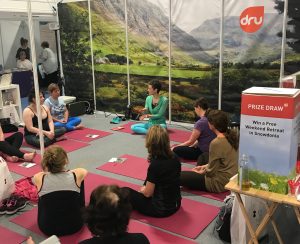
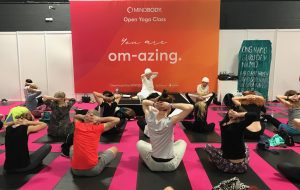
The workshop areas were easy to find and the cost of these longer, intensive classes ranged from £5 – £10 for between 60 and 90 minutes – another great value way to try new things with national or international teachers.
Vegan Life and Mind Body Soul Experience
I briefly popped into Vegan Life Live because I know the food on offer is far superior to any of my own creations. As usual there was a great variety of food on offer as well as clothing, books and workshops to look at. I didn’t spend long in the show, but it was busy inside. I visited Home Kitchen Vegan again for the finest Asian food I have ever tasted!
The MBS Experience looked noticeably depleted this year. There were some familiar stands and faces from previous years, but none of the more interesting meditation, sound experiences and alternative therapies that have previously featured. I’d only recommend a visit to this show if there is a particular Tarot card reader or MBS practitioner that you want to see; otherwise it doesn’t have much to entertain you past the 30 minute mark.
Would I recommend the Om Yoga Show?
Definitely! This show remains a real bargain to visit and with all the free experience areas you can make a full day of it without spending more. If you do want a longer workshop, you can see world leading teachers for a bargain price. There is enough to entertain you for a morning or afternoon if you’re not doing an additional workshop or easily a full day with the extras. I noticed that the variety of clothing stands wasn’t quite as diverse this year but I loved the new additions of gongs and stands with a charitable or education focus.

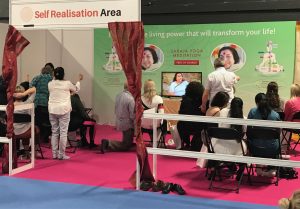
The show desperately needs more areas for meditation and mindfulness and this should be a focus for next year as it was noticeably absent. The noisy atmosphere of the show means that people are often drawn to the quiet areas; and whilst there were places to sit, there were few places to enjoy a peaceful experience and try something new.
The Om Yoga Show is back next in London on 19th – 21st October 2018.
How to Sleep Well and Rise Well in the Darker Months
Regulating your body clock can be a difficult task in the winter months as we set off for work in the dark and come home in the dark. It starts to become a struggle to get out of bed and sleep is often disturbed and unrefreshing. Add in the potential for Seasonal Affective Disorder (SAD) and it can feel like a real challenge to find motivation.
Women are often more susceptible to SAD but also more likely to struggle on without any help. The good news is, that there are some simple essential oil remedies that can both relax you in the evening for restful sleep and energise and motivate you for the day time.
Lavender (lavandula augustifolia) 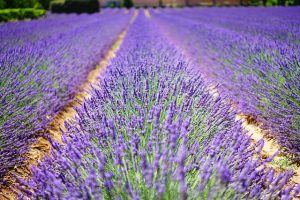
The champion of champions in the aromatherapists kit bag. This wonder plant is very well known for its sleep inducing qualities. It also has the ability to reduce anxiety and emotional stress and is a strong antioxidant making it excellent for pain reduction and skin replenishment. Add a few drops of lavender essential oil to a lavender filled pillow or bag and hang it near the head of the bed. The relaxing, floral aroma will help you drift off.
You can also add a few drops of lavender essential oil to water and using a mist spray bottle, mist your bedding so that the aroma is an encompassing experience.
Lemon (Citrus Limonum)
A long-time favourite of mine, this zesty essential oil is great for enlivening you when the afternoons and dark evenings are dragging and for enhancing concentration. Although lemon is a stimulating oil, it is also calming and works well as a pairing for lavender or on its own. As an extra benefit, lemon is great for calming the digestive system.
Add a few drops to a burner mixed with water to freshen the air after a long day at work (this is when mixing lemon with lavender would be a winning combination) or for use during the day, add a drop or two to a tissue and inhale the refreshing aroma while at your desk or in the car. If you don’t like the fragrance of lemon, you can try grapefruit essential oil instead.
Jasmine (Jasminum Officinale)
Jasmine has a distinctive sweet and flowery fragrance which can be quite heady for some. It does however, have great properties for relieving the blues that often come when the darker months are dragging on. When vaporised (by placing in a burner with some water) Jasmine stimulates the autonomic nervous system and enlivens and awakens the mind and body. It is also excellent as a room fragrance and can be mixed with water for use in a mist spray bottle.
Rose (Rosa Damascena) 
Known for its strong but pleasing floral fragrance, rose essential oil is excellent for calming anxiety or stress and is a friend to those who struggle to regulate sleeping in the darker months. Inhaling rose essential oil through vaporisation (by placing in a burner along with some water) will relax the mind and body. Not a scent to be used when looking for alertness, the properties of this oil are all about relaxation. It has a beneficial uplifting effect on the mood, but really helps sooth the body into a good night’s sleep.
Sandalwood (Santalum Album)
Sandalwood has been used for many hundreds of years for its antidepressant and anti-anxiety qualities. It is also recognised for its properties of focusing the mind. By adding a few drops of sandalwood to a tissue and inhaling throughout the day, it can help to improve the mood and attentiveness but also calm and relax the body.
Sandalwood makes an excellent room fragrance when vaporised, but has the same beneficial properties when burnt in the form of cones or incense sticks. The fragrance can be a little overpowering for some, so as an essential oil it should be used sparingly.
Mental Health Awareness with 1st Armitage Scout Group
The importance of raising awareness and recognition of mental health conditions is gaining a lot of support in the press and is high on the agenda for employers and health groups. It was great to hear that the Scout Troop Leaders at Armitage were exploring the theme of mental health with the Scouts over a number of weeks. Different activities were tried by the Scouts to encourage stress reduction and ways of helping to improve mental health.
I was invited along to teach a yoga class for the Scouts including some relaxation and meditation. There were around 30 Scouts ranging from 10 – 16 years old and all very eager to get started with yoga! I gave an introduction telling the Scouts how yoga can help improve mental health through concentration in the present moment, release of endorphins and breath control.
We tried some breathing exercises to lower the heart rate and increase oxygen circulation before going into a class themed with animal postures to keep the Scouts engaged throughout. After some downward dogs, dolphins, camels, tigers and flamingos thrown into the mix, we settled down to a final relaxation of counted breath. Surprisingly, quiet came to the room as everyone concentrated on their relaxation.
The session was a big success with the Scouts and the Troop Leaders who joined in, and gave a valuable taste of an alternative method for improving mental health.
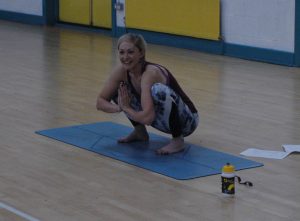
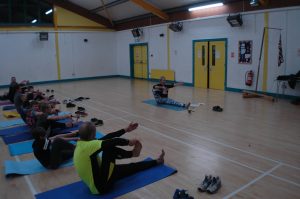
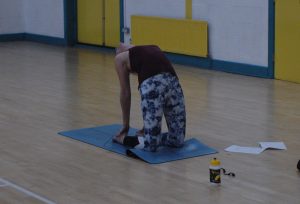
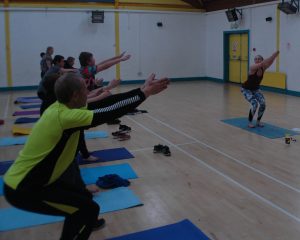
Mindfulness Courses Now Available
Mindfulness is a practice of widening our awareness and insight so that we can live in the present moment without judgment. The ability to watch our minds and the busyness within as an observer rather than through grasping onto thoughts, allows us to experience a greater freedom and peace of mind. The skills of mindfulness can be used in daily life to reduce stress and anxiety, be more productive and develop better relationships at work and at home and lead to a greater sense of physical and mental wellbeing.
The following mindfulness courses are now available in Stafford:
Introduction to Mindfulness—single session course (£25)
Available on the following dates from 6 pm—8 pm:
Tuesday 6th February
Tuesday 13th February
Eight Session Mindfulness Practitioner Course (Introductory offer price £130)
Course starts on Tuesday 27th February and runs weekly with one home practice week at week 5. Each session runs from 6 pm—7.30 pm.
Courses are held in a town centre location with nearby parking. Course materials will be provided.
For more information, visit the Mindfulness tab
Holistic Health Show 2017 – show review 21-22 May
This was my first visit to the Holistic Health Show which is held at the NEC in Birmingham in May each year.
The venue is ideal for this kind of thing so not much needs to be said – lots of space, lots of parking. The parking charge remains scandalous at a £12 flat fee but with free show entry when you pre-register online, you can’t really complain.
Once inside there were goody bags available but it was an immediate bun-fight to grab one before the meagre supplies ran out. As it turns out, it was just a massive paper bag with a cosmetics catalogue inside. I ditched mine as soon as possible as it was a hindrance rather than an help when navigating the very busy show.
The Holistic Health show shares a hall with Hair & Beauty UK. Unfortunately about 80% of the space is hair and beauty with the Holistic Health Show taking up a very small proportion of the event. That said, there were lots of useful stands and exhibitors offering advice, products and workshops. I enjoyed a free meditation session; difficult in the hustle and bustle but worthwhile. There were some great product stands and retailers for aromatherapy in particular.

There was also a free presentation area where speakers delivered sessions throughout the day. I enjoyed a very enlightening session with Cain Leathem of GB Fitness on nutrition and the importance of real ‘personal’ training plan to develop real physical and mental strengths. This appealed to me as I’ve always struggled to gain weight in a health way. I found Cain’s presentation to be genuine and enjoyable.

There was also a large CPD area where sessions could be booked prior to the show and paid for online. A lot of the CPD was very specialised and focused; as a student, I didn’t find this particularly appealing and so didn’t part with my money on this occasion. It might be more worthwhile as a practitioner. Sessions were priced at £15 each but were wide-ranging from therapy for pregnant clients to using essential oils for cancer therapy.
Hair and Beauty UK was an eye-opening experience and was about as far removed from holistic therapy as you could find. I enjoyed looking at some of the bizarre and fantastic treatments in action, but there wasn’t anything that appealed to me in that part of the show.
Unfortunately the holistic side of the show was limited and only took up about 2 hours of my time including the workshop and meditation so it wasn’t a day out. I would go again utilising the free online registration and possibly doing some CPD in the future. It’s not a show that would induce me to part with the £10-£20 on-the-door ticket price however.
The Holistic Health Show is back at the NEC on 20 -21 May 2018
OM Yoga Show 2017 – Manchester show review 19-21 May
This was my sixth visit to the Om Yoga show and the second time I’d been to it in Manchester. At £7.50 entrance fee this is a true bargain. After a succession of London venues that seem to be impossibly difficult (and time consuming) to get to, I thought the chance to drive ‘up north’ would be welcome.
The new venue at Event City was an excellent choice! Loads of free parking right outside the door. It was easy to get to and refreshingly didn’t involve multiple bus/train journeys and lots of waiting around – something that can’t be avoided in getting to the London venues of Alexandra Palace and Olympia.

Goody bags were freely available – no scrum necessary – just inside the door. We were able to help ourselves to show guides and freebies (powdered, vegan supplements for smoothies). The venue was large with lots going on this year. I always feel like the Manchester show might be the poor relation of the London event, but not true this year.
The bonus is that as it’s not as busy as the London show, you can actually get the chance to get into the open classes without a 30 minute queue and this year was the first time I’d managed to book onto my first choice workshop.
The best thing about the Om Yoga show is that it’s a hive of thriving young British businesses – loads of innovation and creativity in clothing, food, drink, styles of yoga and equipment that are freely available to us British yogis.
There was a strong display of exhibitors from therapists, food producers, tea importers, meditation aids, equipment, books, clothing, accessories and interiors. Really everything you’d want to see at this kind of show and far more. The Manchester show is definitely not a runner-up to London any more.
There were 3 open class studios, a children’s yoga studio and a meditation area this year. Classes ranging from gentle introductions, innovative new styles, traditional asanas, challenging backbends and arm balances and focus on all 8 limbs of yoga with some Ayurveda and holistic therapy thrown in. There were 93 free classes to choose from this year so it’s not just a day of shopping and browsing – there are multiple good quality activities to fill the day as well. With about 15 workshops per day ranging from £5 to £10 there were also some world class teachers to choose from for a more in-depth experience. I booked onto a masterclass with Yogi Ashokananda for £10 – the best yoga class I have ever been to! My workshop review can be found here.
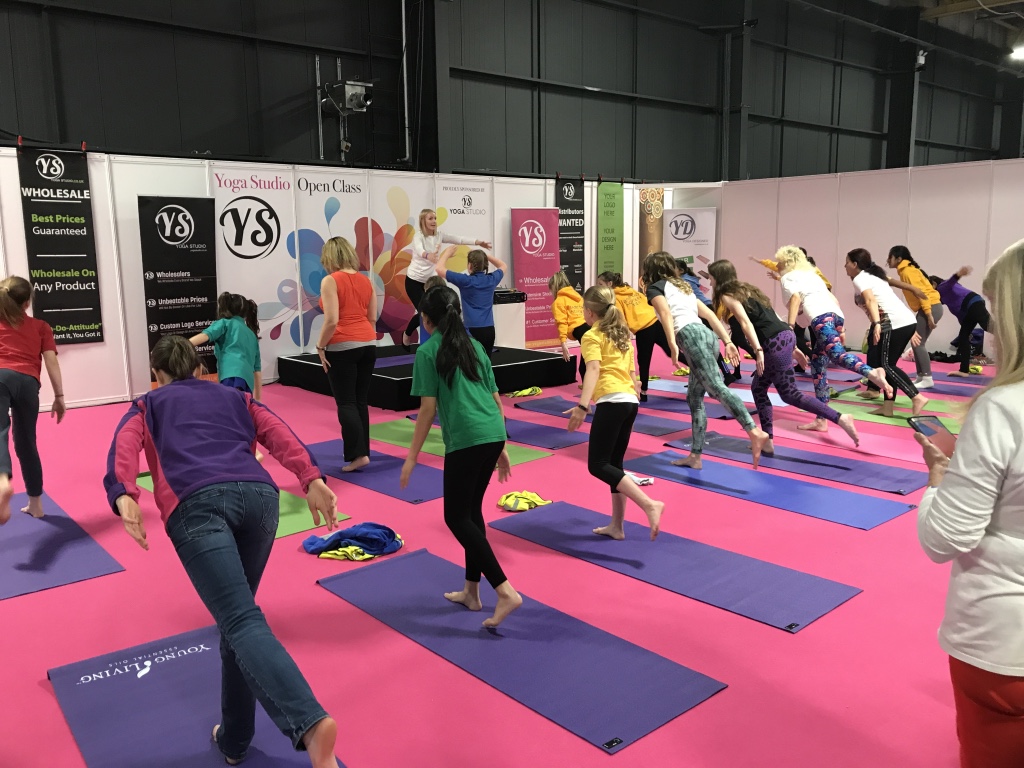
The hot yoga pod was absent this year, but had been replaced by an aerial yoga workshop space. I like that the Om Yoga show encourages attendees to get stuck into new incarnations of yoga as well as sticking to the traditional. Whatever your viewpoint on yoga, there will be something for you to enjoy here.

No review would be complete without a mention of the vegan food court – AMAZING! This year was the best selection of food I’ve ever seen at the show. So many local home kitchens and creative vegan cooks. It was hard to choose, but a special mention needs to go to Home Kitchen Vegan who produced the most fantastic vegan curry.
Special mention to my favourite exhibitors this year:
Yoga clothing to die for The Power of Greyskull
Yoga bliss from a world class teacher Yogi Ashokananda
I dare you to leave without trying one of these drinks by Big Juice
The Om Yoga Show will be back in London 20 – 22nd October 2017
Essential oils for stress relief
Scents can be very powerful…triggering memories of people, places and events. They can be very emotive, causing changes in our state of mind as well as impacting on our bodies through the nervous system.
The olfactory nerve that gives us our sense of smell is connected directly to the brain. From here, signals stimulate many different responses throughout the body including being able to trigger physical reactions through working on the autonomic nervous system. Scents can send our body into fight or flight, or they can bring us back to calm.
Essential oils work on the principal of balance; bringing the body mind and spirit back into balance after the stresses and strains of modern life have left us neglecting areas of our wellbeing. Some essential oils have a similar effect on neuroreceptors as many synthetic anti-anxiety medications. On the whole, essential oils work holistically rather than treating a symptom, for a better long-term outlook.
Lavender is one of the most studied essential oils. It calms the nervous system, lowering blood pressure and heart rate, reduces anxiety and promotes sleep. Try adding a few drops of lavender oil to a tissue to inhale throughout the day or add to bath water to gain the full effects.
Bergamot is a symbol of the change from winter to spring as the fruits ripen, making it the ideal scent to try in April. Studies have shown that bergamot is excellent for reducing stress, lowering blood pressure and reducing the heart rate sending the body into relaxation. It can also reduce chronic pain through its relaxing properties. Try mixing a few drops with water and adding to a burner to fill a room with scent.
